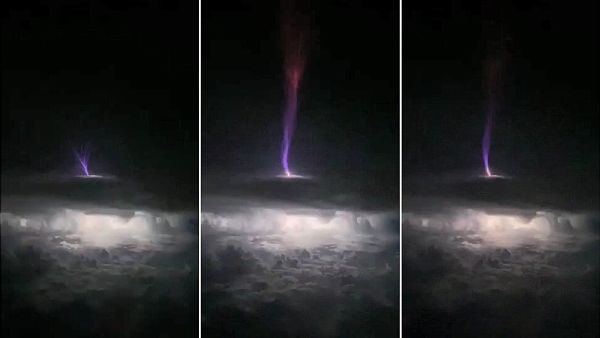The “gigantic jet” that launched into space could have been the strongest lightning strike ever recorded.
This lightning bolt over Oklahoma was one of the rarest and most powerful on Earth.
The rain picks up in intensity, the sky darkens, and lightning crackles across the atmosphere. However, this lightning bolt does something unexpectedly: it doesn’t strike down toward the ground or go sideways through clouds. It shoots straight up, 50 miles (80 kilometers) into the air, brushing the bottom border of space as it leaves the top of the cloud.

Bolts like this are known as enormous jets. Scientists have just discovered the most potent enormous jet ever. These uncommon and intense lightning strikes only happen as few as 1,000 times a year and produce more than 50 times as much energy as a conventional lightning bolt.
Researchers examined a huge jet that emerged from a cloud above Oklahoma in 2018 for a study that was published on August 3 in the journal Science Advances. The team discovered that the bolt moved about 300 coulombs of energy, or about 60 times the 5-coulomb output of a typical lightning bolt, from the top of the cloud to the lower ionosphere, the layer of charged particles that separates Earth’s upper atmosphere from the vacuum of space, using satellite and radar data to study the jet’s radio-wave emissions.
The charge transfer is equivalent to the greatest ever reported for cloud-to-ground strokes and is nearly twice as large as the previous largest by a massive jet, according to the study’s authors.
It took an equally tremendous amount of luck to be able to record such precise information about the big bolt of lightning. Using a low-light camera, a citizen scientist near Hawley, Texas, captured the jet on May 14, 2018, as it burst out of a cloud top and connected with charged particles in the ionosphere, 60 miles (96 km) above the earth.
As fate would have it, the jet happened quite close to the center of a massive lightning mapping array (LMA), which is a system of ground-based radio antennae used to track the locations and times of lightning strikes. This information was discovered by scientists who examined the video. A network of weather-monitoring satellites and a number of weather radar stations were also within visual range of the airplane.
Combining these sources allowed the researchers to conduct an unprecedented-depth analysis of the enormous jet’s size, structure, and energy production. According to lead study author Levi Boggs, a research scientist at the Georgia Tech Research Institute, streamers, which form at the very tip of a lightning bolt and establish a “direct electrical connection between the cloud top and the lower ionosphere,” were the source of the jet’s highest-frequency radio-wave emissions (the kind that LMAs are designed to detect).
Meanwhile, a region known as the leader was far farther behind the streamers and carried the greatest electric current. The data also revealed that the leader was extremely hot, with a temperature of more than 8,000 degrees F, while the streamers were comparatively cool, with a temperature of about 400 degrees Fahrenheit (204 degrees Celsius) (4,426 C). The researchers found that this disparity applies to all lightning hits, not only massive jets.
So why does lightning occasionally flash upward rather than downward? Huge jets are generally seen in storms that don’t produce many cloud-to-ground lightning strikes, the researchers stated, suggesting that it may entail some form of obstruction that stops lightning from leaving through the bottom of a cloud.
Cloud-to-ground discharges are often suppressed for unknown reasons, according to Boggs. “The massive jet may relieve the buildup of surplus negative charge in the cloud in the absence of the lightning discharges we regularly observe.”
The scientists also discovered that reports of gigantic aircraft are especially common in tropical areas. The fact that the record-breaking jet above Oklahoma was not a part of a tropical storm system makes it all the more amazing. To comprehend these extraordinary, upside-down lightning strikes, additional study—and a lot more good fortune—is required.
Originally published on Live Science.
Do not forget to share your opinion with us to provide you with the best posts !



0 Comments